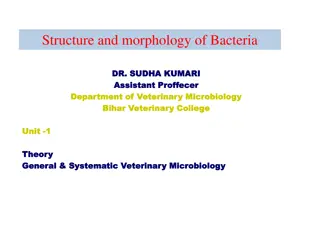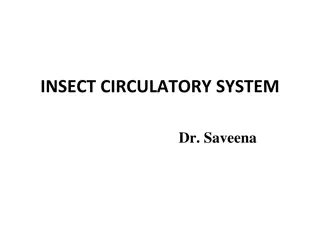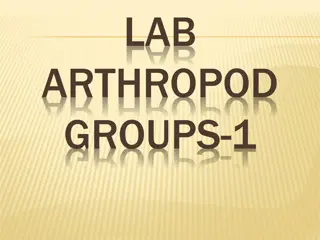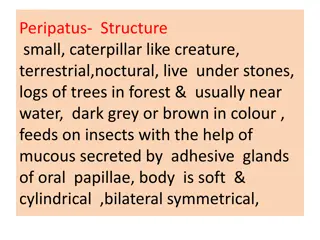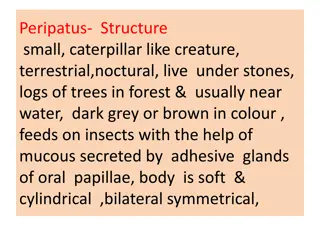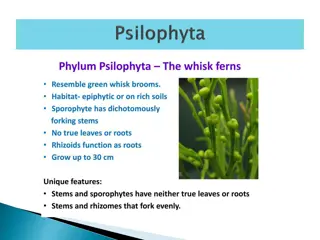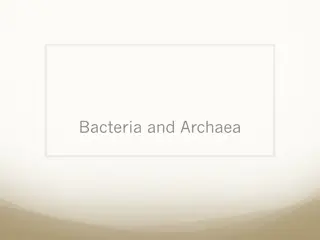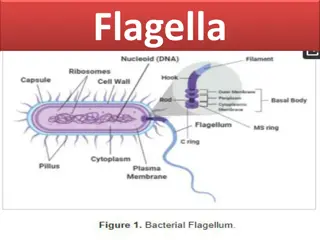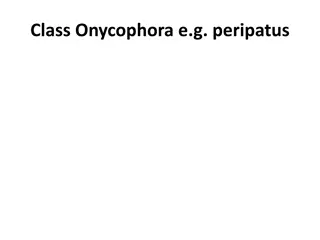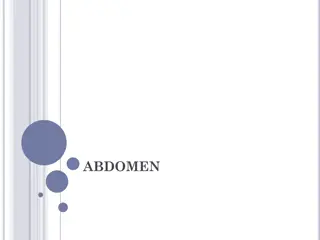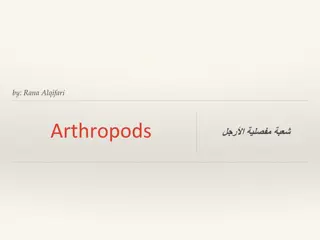Insect Abdominal Structures and Appendages: An Overview
The abdomen of insects plays crucial roles in respiration, reproduction, digestion, excretion, and metabolism. The number of abdominal segments varies across species, with reductions and modifications seen in different insect groups. From the propodeum to pregential and postgenital segments, each pa
1 views • 6 slides
Overview of Bacterial Structure and Morphology in Veterinary Microbiology
Bacteria are single-celled prokaryotic organisms with a simple body design. Their structure includes layers such as the extramural layer, surface appendages like flagella and pili, cell envelop with a cell wall and cytoplasmic membrane, and cytoplasmic inclusions. The capsule and slime layer play es
0 views • 21 slides
Exploring Bacterial Flagella: Structure and Function
Bacterial flagella are long, thin appendages crucial for motility in bacteria. Composed of filament, basal body, and hook, these structures play a vital role in bacterial movement. This article dives into the detailed structure and functionality of bacterial flagella, highlighting their importance i
0 views • 9 slides
Insect Circulatory System: Overview and Functions
The insect circulatory system comprises an open type, where blood flows through the body cavity. Divided into three sinuses, it houses vital organs such as the heart and nerve cord. The dorsal vessel acts as the main organ of circulation, along with accessory pulsatile organs that supply blood to ap
0 views • 19 slides
Overview of Arthropods: Classification and Characteristics
Arthropods are a diverse group of invertebrates characterized by segmented bodies, appendages, and chitinous exoskeletons. They belong to the Phylum Arthropoda and are classified into four important classes: Myriapoda, Crustacea, Arachnida, and Insecta. This article explores the unique features of e
0 views • 18 slides
Detailed Overview of Peripatus Structure and Anatomy
Peripatus, a small terrestrial nocturnal creature resembling a caterpillar, lives under stones and logs near water. Its body is cylindrical with indistinct segmentation and superficial ring-like annuli. The head features antennae, mandibles, and oral papillae, while the trunk bears walking legs with
2 views • 27 slides
Anatomy and Characteristics of Peripatus
Peripatus is a small, caterpillar-like terrestrial creature found in forests near water. It has dark grey or brown color, feeds on insects using mucous secreted by adhesive glands, and has a soft cylindrical body with bilateral symmetry. The body is divided into a head and trunk, with distinct featu
1 views • 27 slides
Characteristics of the Genera Psilotum and Tmesipteris
The class represented by Psilotum and Tmesipteris features rootless sporophytes with subterranean rhizomes and aerial shoots, dichotomous branching, rhizoids for nutrient absorption, scale-like or leaf-like appendages, protostelic or siphonostelic stele, eusporangiate sporangial development, homospo
0 views • 9 slides
Bentham's View on Law: Essential Elements and Eight Aspects Explained
Bentham's perspective on law, as presented by Assistant Professor Rinkey Sharma, delves into the definition and essential elements of law according to Bentham. This includes discussing the source of law, its subjects, objects, extent, aspects, force, remedial state appendages, and expression. The es
0 views • 9 slides
Understanding the Common Integuments and Skin Anatomy
The common integuments encompass the skin, hairs, skin glands, claws, hooves, and horns, playing vital roles in protection, thermoregulation, and drug administration. The skin's structure consists of the epidermis and dermis layers, renewing continuously to maintain its functions. Additionally, nail
0 views • 11 slides
Understanding Bacterial Form and Function: Structures, Shapes, and Arrangements
Explore the diverse structures common to bacterial cells, including membranes, ribosomes, and chromosomes. Learn about the shapes and arrangements of bacteria, such as cocci, bacilli, and spirilla. Discover external appendages that provide motility and aid in attachment and mating.
0 views • 85 slides
Understanding Bacterial Flagella: Structure and Function
Bacterial flagella, known as flagellum, are hairlike appendages responsible for swimming motility. They are composed of three parts - the filament, basal body, and hook. The filament is a hollow cylinder made of flagellin protein subunits. The synthesis of flagella involves multiple genes. This arti
0 views • 6 slides
Overview of Class Onycophora (Peripatus) Characteristics and Traits
Class Onycophora includes organisms like Peripatus, characterized by features such as possessing a thin cuticle, soft muscular body wall, scattered spiracles, cilia in genital organs, and wormlike body structure with unsegmented legs. They exhibit separate sexes, direct development, and possession o
0 views • 100 slides
Diseases of Skin Overview and Primary Lesions by Dr. Sonam Bhatt, Assistant Professor VMD Basu Patna
Skin, the largest organ of the body, plays a crucial role in regulating temperature and acting as a protective barrier. It consists of the epidermis, dermis, and subcutis, along with skin appendages like hair and claws. Skin lesions can be categorized into primary and secondary, with primary lesions
0 views • 18 slides
Understanding the Abdomen in Insects
The abdomen in insects is a crucial body region composed of 11 segments, each with specific functions such as bearing external genitalia and ovipositors. It is divided into pregenital, genital, and postgenital segments, with appendages specialized for reproduction. The ovipositor, essential for egg-
0 views • 17 slides
Fascinating World of Arthropods: Diversity and Characteristics
Arthropods, the largest phylum in the animal kingdom, exhibit a wide array of characteristics and play crucial roles in various ecosystems. From crustaceans to insects, these invertebrates showcase segmented bodies, jointed appendages, and diverse respiratory systems. Explore the world of arthropods
0 views • 12 slides

